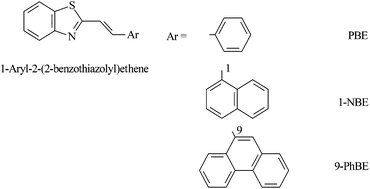Aromatic ring size effects on the photophysics and photochemistry of styrylbenzothiazole†
Abstract
The effect of ring size on the photophysics and photochemistry of

* Corresponding authors
a
Chemistry Department, Faculty of Science, Tanta University, Tanta, Egypt
E-mail:
mohamed.awad1@science.tanta.edu.eg
b The SFI Strategic Research Cluster in Solar Energy Conversion and the Centre for Synthesis and Chemical Biology, School of Chemical and Bioprocess Engineering, University College Dublin, Belfield, Dublin 4, Ireland
The effect of ring size on the photophysics and photochemistry of

 Please wait while we load your content...
Something went wrong. Try again?
Please wait while we load your content...
Something went wrong. Try again?
M. K. Awad, M. M. El-Hendawy, T. A. Fayed, S. E. H. Etaiw and N. J. English, Photochem. Photobiol. Sci., 2013, 12, 1220 DOI: 10.1039/C3PP25367H
To request permission to reproduce material from this article, please go to the Copyright Clearance Center request page.
If you are an author contributing to an RSC publication, you do not need to request permission provided correct acknowledgement is given.
If you are the author of this article, you do not need to request permission to reproduce figures and diagrams provided correct acknowledgement is given. If you want to reproduce the whole article in a third-party publication (excluding your thesis/dissertation for which permission is not required) please go to the Copyright Clearance Center request page.
Read more about how to correctly acknowledge RSC content.
 Fetching data from CrossRef.
Fetching data from CrossRef.
This may take some time to load.
Loading related content
